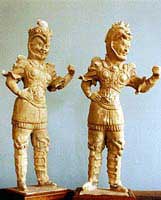 |
|
Artifacts from the Sui Dynasty |
Archaeologists in Shaanxi Province, Northwestern China, have discovered a tomb dating back 1,300 years in Tongguan County, unearthing a substantial collection of precious artifacts.
Located in Shuicun village, about 10 km northwest of Tongguan County, the tomb was constructed during the Sui Dynasty (581-618 AD). Archaeologists have uncovered 72 square meters of well-preserved murals and excavated over 200 artifacts, including numerous pottery items and a stone coffin.
The two-story tomb is semicircular, standing 5 meters tall with a diameter of over 6 meters. Its four walls are adorned with images of noblewomen, while the ceiling is decorated with silver dots symbolizing stars. A white band across the ceiling represents the Milky Way.
The entrance to the tomb is 21 meters long and more than 2 meters wide, with walls on either side covered in depictions of 46 individuals on a journey. A large stone coffin, measuring 3 meters long and 2 meters wide, is situated in the southeast corner of the chamber. The coffin features carvings of celestial bodies, mythical creatures, and intricate patterns.
Li Ming, an archaeologist at the Shaanxi Provincial Archaeological Research Institute, stated that the tomb likely belonged to a member of the royal family, possibly a crown prince. The tomb has been looted of many valuable artifacts, including an inscription stele.
According to experts, the wall paintings and the stone coffin provide significant information for studying the development of painting during the Sui Dynasty and subsequently the Tang Dynasty (618-907 AD).

















































